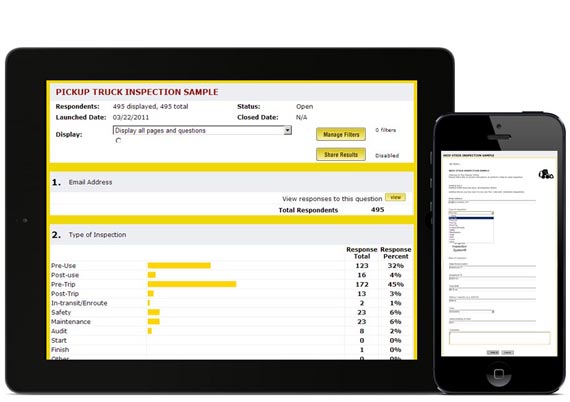Most companies and their commercial vehicle operators are familiar with the legal requirement that each driver inspect their commercial vehicle each day.
If a driver is pulled over without documentation that the inspection was done, the result is a citation and a fine.
But what many don’t realize is that the documentation doesn’t have to be “in writing,” with an actual handwritten signature. Inspections can be done digitally, with the documentation recorded in software.
Digital Has Widespread Legal Acceptance
Both the U.S. National Highway Traffic Safety Administration (NHTSA) and the Ministry of Transportation of Ontario (MTO) have accepted digital evidence of inspections for many years.
In a 2003 memo explaining the NHTSA’s acceptance of e-inspections, the agency’s assistant administrator and chief safety officer at the time, Brian McLaughlin, demonstrated a full awareness of why enterprises would want to enter inspection results into mobile computing devices rather than use paper forms.
“We are taking this action to allow motor carriers to immediately use advanced technology to reduce to the greatest extent practicable the cost of complying with the record keeping requirements of 40 CFR Part 396,” McLaughlin wrote, referring to the regulation that mandates daily inspections.
The NHTSA’s regulations had always been construed to mean an actual signature on a piece of paper documenting the inspection, but the NHTSA memo makes it clear that the agency doesn’t want to prohibit companies from taking advantage of the latest technology to improve their efficiency.
“While there is an obvious need to have motor carriers and their employees certify that specific safety-related tasks have been performed, we do not believe that the certification process should be limited strictly to signatures on paper records,” the memo states.
There are of course specific requirements related to the use of e-inspections. The MTO, for example, requires nine specific items to be entered into each electronic inspection report, including the electronic signature from the person who conducted the inspection, as well as all other drivers.
But these requirements are no more onerous than the requirements for paper documentation. So why isn’t use of e-inspections more widespread?
In addition to misconceptions about the legality of e-inspections, e-inspection adoption has been hindered by a lack of e-inspection software that actually makes inspections easier and more cost-efficient. Without this technology, there’s been no compelling reason to make the switch from paper to digital.
But with fully integrated e-inspection solutions such as The Checker inspection software—usable in the field on any connected mobile device—the technology has finally caught up with the regulations.
The Benefits of Digital
There’s nothing wrong with using paper forms to document daily inspections. For many companies, paper works great.
However, e-inspections do have some key advantages that are causing more and more companies to switch to digital, including:
- Immediately aggregated inspection data for business intelligence (without having to key in information in the office).
- Faster inspections.
- Minimization of human error.
- Reduction of paper costs.
- Tracking of compliance with the company’s inspection policy.
- Appeal to employees who like working with technology.
You should be sure of the regulations that apply to your location and to the types of equipment you use, but in almost all cases, there’s no law at all stopping you from gaining these advantages by moving from paper to digital documentation of daily inspections.











